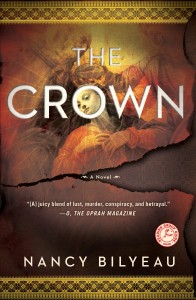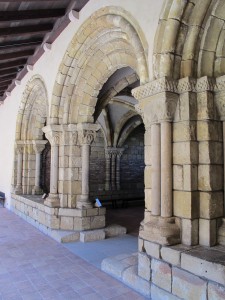Interview with Nancy Bilyeau, Author of The Crown
It is my very great pleasure today to welcome friend and fellow historical fiction writer Nancy Bilyeau to the blog. Nancy’s riveting historical thriller The Crown released in paperback earlier this month. Critically acclaimed since its hardcover debut in January, “O” (The Oprah Magazine) called The Crown, “A juicy blend of lust, murder, conspiracy, and betrayal.” I’ve read it. O is right.
First a blurb to tantalize you: London, May 1537. When Joanna Stafford, a novice nun, learns her cousin is about to be burned at the stake for rebelling against Henry VIII, she makes a decision that will change not only her life but quite possibly, the fate of a nation. Joanna breaks the sacred rule of enclosure and runs away from Dartford Priory to bear witness to her cousin’s execution.
Arrested along with her father at the site of the burning and sent to the Tower of London, Joanna finds herself a pawn in a deadly power struggle. Those closest to the throne are locked in a fierce fight w those desperate to save England’s monasteries from destruction. Charged with a mission to find a hidden relic believed to possess a deadly mystical power, Joanna and a troubled young friar, Brother Edmund, seek answers and clues across England.
And now some questions to take you behind cover-copy (and it’s no exaggeration to say Nancy reveals some things here she has never told readers before):
1) What inspired you to choose a fictional Dominican nun as the heroine of The Crown?
I first chose to set a book in the 16th century—simply because it is my favorite century from history. I love mysteries and thrillers, and wanted to attempt to write one with a female protagonist. It took me a long time to figure out who would be the person. I didn’t want a royal or lady in waiting, yet someone living in a Tudor village, I feared it would be too hard to inject that woman into conflict that rises to the level of a thriller. A nun struggling for her future in the middle of the Dissolution of the Monasteries—when the Catholic Church was being violently dismantled—could be quite compelling. Finally, I picked a Dominican because there was only one such order in England, and that made it special.
2) I found it refreshing that Joanna stayed “in character”—true to the religious sentiments one would expect a 16th century nun to have. How difficult was it for you to achieve that? Do you think it was a risky choice given you are writing for a modern—and generally rather skeptical—audience?
One of my pet peeves is characters in historical novels who have modern sensibilities. It’s the easy way out. There is some strange part of my personality that compels me toward the most difficult choices. Sometimes I wish it were otherwise! But as soon as I decided on a nun, I was determined to make her authentic to the spiritual values of the period. I didn’t want to write a book with a reluctant nun who is forced into it by her father or retreats to a priory after rejection by a man. Again, that’s the easy way out. I did worry that readers would be turned off by a spiritual woman but I’ve not seen that reaction. Readers of historical fiction are eager for authentic behavior, I’m more convinced of that than ever. Commit anachronisms at your peril!
The way I tried to achieve it was reading what women in religious orders actually wrote: Catherine of Siena, Hildegarde of Bingen, Teresa of Avila. That helped get me in the proper mood. Also a writing teacher recommended I research the lives of the early female Catholic saints, the ones who were torn to pieces in the Roman Coliseum or who became martyrs in the Dark Ages and medieval period. The thinking of these women is about as far from a 21st century mindset as you can get. Just fascinating.
3) Your book doesn’t shy away from the unsavory sights or the more malodorous smells of life in Tudor England. In fact, in Joanna’s opening trip to Smithfield the revolting plays a large role. Of course accurate historical details help bring readers to a specific place and time, but I was struck by your very evident emphasis on the unsavory at the beginning of the book. Why specifically did you choose to highlight the grimy side of the 16th century?
I’ve written screenplays and that is a key part of what I like to do: Write visually. It’s not just dialogue and direct character action. I try to do all the research so I can put you on the street, inside the priory cloister, in a barge on the Thames. I wanted to time-travel the reader from the very beginning: You are on your way to Smithfield on execution day in May of 1537, you’re scared and you’re hungry and you’re exhausted—but still resolute. This is what it would feel like, smell like, sound like. Even taste like.
4) Besides Joanna, who is your favorite character in The Crown? Who is your least favorite? Why?
Brother Edmund is my second favorite—I like to think that he is a pretty original character and for some reason I have tremendous sympathy for him. He’s a mix of strengths and weaknesses. I tried my best to make all the characters nuanced. I don’t like two-dimensional people hurtling through thrillers. Or characters with worn-out identifying descriptions: a natural beauty, a strong-jawed man. Ugh.
My least favorite character? Hmmmm. That’s an interesting question. Did I create a character I personally would dislike? Apart from George Boleyn—and I can’t give away why I wouldn’t want to have encountered him at a tender age, or else that would be a spoiler—it would have to be the young prioress. She was inspired by a boss I once had—a very difficult one. In fact, I drew on my personal work history, my years in the magazine business, when depicting life in the priory. I thought about it a lot, and decided that though the stereotype of a nunnery was of graceful, serene ladies floating down the halls in harmony, I imagined that there would be the rivalries and tensions found in any group of people essentially working together, and in this case living together too. I was very happy to receive an email from a Dominican nun and two emails from friars that said I captured correctly the essential feeling of life in an enclosed religious community. 
5) Where have you traveled for inspiration and research for The Crown?
I’ve traveled to most of the places that Sister Joanna Stafford travels to: Dartford, Smithfield, and the Tower of London. Even though the present Tower is closest to what it was in the 1530s, I felt most connected to Joanna in Dartford, in Kent. I walked along the remains of the stone wall that once surrounded the priory of sisters. That is all that remains.
But since I live in New York City, my research trips to England can’t happen as often as I’d like. For inspiration closer to home, I go to the Cloisters Gardens and Museum of the Metropolitan Museum of Art. For anyone who hasn’t had a chance to visit, go! The Cloisters was assembled in the 1930s from a series of medieval French abbeys that they brought over, brick by brick. The re-created rooms are filled with paintings, sculpture, and exquisite objects contemporary to that time. In fact, I got the idea for a murder weapon in The Crown while walking through the Cloisters! I’ve never told any other interviewer that.
6) Truth is often stranger than fiction. During your research for The Crown what was the most unusual or unexpected thing you discovered?
There were certain things I discovered about King Athelstan, the dark ages Saxon monarch, that really surprised me. As much as the Tudor monarchs are over-exposed in some people’s eyes, Athelstan is under-exposed. He arguably was the first king of Britain after he won a enormous battle against the Vikings and the Scots—and no one even knows where the battle was fought. There’s also the question of his sexuality. So interesting.
7) Authors of historical novels walk a line between known historical facts and fiction. Where do you draw the line on your personal map between accuracy and imagination?
My book is not the kind of historical fiction that tells the story, with imagination and new insights, of famous people who once lived. Some “real” people populate The Crown, but most of the characters are from my imagination. And my thriller plot is rather audacious—that’s what folks tell me. So I mixed the carefully researched truth with the fantastical on many pages.
8. Is there anything you’d like to tell us about the Tudor period which even avid readers of Tudor-era fiction might not know—perhaps a preconception you’d like to overturn?
I had no religious or political agenda whatsoever when I started researching this book. But the deeper I got into it, the more I became convinced that the stereotype of a decaying Catholic church that had lost its relevance was wrong. History certainly was written by the winners when it came to the English Reformation. Dartford Priory, where I set most of the book, was a vital center of intellectual achievement and pious observance. Also there was an infirmary in the town run by the priory as well as an almshouse for the poor, and local girls were taught to read there. All that was eliminated when the priory “surrendered” to the will of Henry VIII and the sisters were turned out.
9) Which is most likely to spark the idea for a Nancy Bilyeau novel—a time period, a specific event or a character?
Time period. I am drawn to the time and place, and after that the characters come. Hmmmm. Is that unusual?

I’d give anything for a lair. I wrote The Crown at the New York Public Library, my kitchen table and various Starbucks. But when I had to write a key scene and needed to get into the mood, I would pack up the laptop and head for The Cloisters. The perfect environment. However, the battery on my laptop would run out in two hours and there are no plugs for writers. Still, I’d take it to the chapter house and sit on the stone “bench” and tap away furiously till the power drained – or the guards started coming after me.
11) If you could read any book again for the first time, what would it be and why?
Rebecca. I read it first when I was in high school and it made a deep and lasting impression on me. I’d like to feel the thrill of some of those revelations again. Since then I’ve re-read it at least six times and come away with a boundless respect for Daphne du Maurier’s craft and also I am so curious about some things in the book. For instance, when Max de Winter tells his second wife that on their honeymoon, Rebecca, laughing, her black hair blowing in the wind, told him things about herself “that I would never repeat to a living soul,” I would love to know—What are those things?
12) I know you are hard at work on the next book in this series, The Chalice, can you share a bit about the new book?
It’s my sequel to The Crown. It’s darker in some ways, with even higher stakes. More executions. And more romance too.
13) In The Crown a Joanna brushes elbows with a number of famous historical characters like Catherine Howard and Stephen Gardiner, Bishop of Winchester, can we expect more cameos from the rich and famous in your sequel? Who might we meet?
Oh I had such a fantastic time researching the “real” people of the time. Gardiner returns, of course; this time Joanna encounters not one but two women who marry Henry VIII. There are a number of aristocrats of the time who played very important parts in history but are not often written about—I put them to work in The Chalice. And finally, Joanna comes face to face with none other than Thomas Cromwell.
About Nancy: Nancy Bilyeau is a writer and magazine editor who has worked on the staffs of InStyle, Rolling Stone, and Ladies’ Home Journal. She is currently the executive editor of DuJour magazine. She was born in Chicago and grew up in Michigan, earning a bachelor’s degree from the University of Michigan. Now she lives in New York City with her husband and two children. The Crown was nominated for an Ellis Peters Historical Dagger Award 2012 by the Crime Writers’ Association, given to Best Historical Crime Novel. Nancy has finished writing a sequel to The Crown, which is called The Chalice.
Comments are closed.